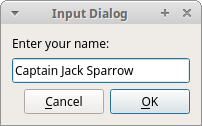PyQt6 的对话框
对话是两个或更多人之间的交谈。在计算机程序中,对话框是用于与应用程序 “交谈” 的窗口,用于诸如从用户那里获取数据或更改应用程序设置之类的事情。
PyQt6 QInputDialog
QInputDialog 提供了一个简单方便的对话框来从用户那里获取输入。输入值可以是字符串、数字或列表中的项目。
#!/usr/bin/python
# file: input_dialog.py
"""
ZetCode PyQt6 tutorial
In this example, we receive data from
a QInputDialog dialog.
Aauthor: Jan Bodnar
Website: zetcode.com
"""
from PyQt6.QtWidgets import (QWidget, QPushButton, QLineEdit,
QInputDialog, QApplication)
import sys
class Example(QWidget):
def __init__(self):
super().__init__()
self.initUI()
def initUI(self):
self.btn = QPushButton('Dialog', self)
self.btn.move(20, 20)
self.btn.clicked.connect(self.showDialog)
self.le = QLineEdit(self)
self.le.move(130, 22)
self.setGeometry(300, 300, 450, 350)
self.setWindowTitle('Input dialog')
self.show()
def showDialog(self):
text, ok = QInputDialog.getText(self, 'Input Dialog',
'Enter your name:')
if ok:
self.le.setText(str(text))
def main():
app = QApplication(sys.argv)
ex = Example()
sys.exit(app.exec())
if __name__ == '__main__':
main()这个示例有一个按钮和行内编辑部件,按钮打开输入一个对话框,对话框里有一个文本输入框,用户输入的文本会显示在行内编辑部件里。
text, ok = QInputDialog.getText(self, 'Input Dialog',
'Enter your name:')这行代码打开了输入对话框,第一个参数是对话框标题,第二个参数是对话框里的提示信息。对话框会返回输入的文本和一个布尔值。如果点击 OK 按钮,这个布尔值是 true。
if ok:
self.le.setText(str(text))使用 setText() 从对话框里获取输入的文本。

图示:输入框
PyQt6 QColorDialog
QColorDialog 是可以选择颜色对话框。
#!/usr/bin/python
# file: color_dialog.py
"""
ZetCode PyQt6 tutorial
In this example, we select a color value
from the QColorDialog and change the background
color of a QFrame widget.
Author: Jan Bodnar
Website: zetcode.com
"""
from PyQt6.QtWidgets import (QWidget, QPushButton, QFrame,
QColorDialog, QApplication)
from PyQt6.QtGui import QColor
import sys
class Example(QWidget):
def __init__(self):
super().__init__()
self.initUI()
def initUI(self):
col = QColor(0, 0, 0)
self.btn = QPushButton('Dialog', self)
self.btn.move(20, 20)
self.btn.clicked.connect(self.showDialog)
self.frm = QFrame(self)
self.frm.setStyleSheet("QWidget { background-color: %s }"
% col.name())
self.frm.setGeometry(130, 22, 200, 200)
self.setGeometry(300, 300, 450, 350)
self.setWindowTitle('Color dialog')
self.show()
def showDialog(self):
col = QColorDialog.getColor()
if col.isValid():
self.frm.setStyleSheet("QWidget { background-color: %s }"
% col.name())
def main():
app = QApplication(sys.argv)
ex = Example()
sys.exit(app.exec())
if __name__ == '__main__':
main()示例里有个按钮和一个 QFrame。部件的背景颜色是默认颜色,可以使用 QColorDialog 修改部件的背景颜色。
col = QColor(0, 0, 0)这是 QFrame 的初始背景色。
col = QColorDialog.getColor()这一行弹出 QColorDialog。
if col.isValid():
self.frm.setStyleSheet("QWidget { background-color: %s }"
% col.name())这里检查了颜色是不是有效的。如果点击取消按钮,没有返回可用的颜色值。如果返回的颜色是有效值,就使用样式表修改背景颜色。
PyQt6 QFontDialog
QFontDialog 是选择字体的对话框。
#!/usr/bin/python
# file: font_dialog.py
"""
ZetCode PyQt6 tutorial
In this example, we select a font name
and change the font of a label.
Author: Jan Bodnar
Website: zetcode.com
"""
from PyQt6.QtWidgets import (QWidget, QVBoxLayout, QPushButton,
QSizePolicy, QLabel, QFontDialog, QApplication)
import sys
class Example(QWidget):
def __init__(self):
super().__init__()
self.initUI()
def initUI(self):
vbox = QVBoxLayout()
btn = QPushButton('Dialog', self)
btn.setSizePolicy(QSizePolicy.Policy.Fixed, QSizePolicy.Policy.Fixed)
btn.move(20, 20)
vbox.addWidget(btn)
btn.clicked.connect(self.showDialog)
self.lbl = QLabel('Knowledge only matters', self)
self.lbl.move(130, 20)
vbox.addWidget(self.lbl)
self.setLayout(vbox)
self.setGeometry(300, 300, 450, 350)
self.setWindowTitle('Font dialog')
self.show()
def showDialog(self):
font, ok = QFontDialog.getFont()
if ok:
self.lbl.setFont(font)
def main():
app = QApplication(sys.argv)
ex = Example()
sys.exit(app.exec())
if __name__ == '__main__':
main()本例中,有个有文本的按钮。使用 QFontDialog 可以修改按钮文本的字体。
font, ok = QFontDialog.getFont()这里弹出了字体选择对话框。getFont 方法返回了选择的字体名称和 ok 参数,如果点击 Ok 按钮,ok 的值是 True,反则是 False。
if ok:
self.label.setFont(font)如果点击 Ok 按钮,setFont 方法会修改文本的字体。
PyQt6 QFileDialog
QFileDialog 是选择文件或者文件夹的对话框,可以用作选择或者保存操作。
#!/usr/bin/python
# file: file_dialog.py
"""
ZetCode PyQt6 tutorial
In this example, we select a file with a
QFileDialog and display its contents
in a QTextEdit.
Author: Jan Bodnar
Website: zetcode.com
"""
from PyQt6.QtWidgets import (QMainWindow, QTextEdit,
QFileDialog, QApplication)
from PyQt6.QtGui import QIcon, QAction
from pathlib import Path
import sys
class Example(QMainWindow):
def __init__(self):
super().__init__()
self.initUI()
def initUI(self):
self.textEdit = QTextEdit()
self.setCentralWidget(self.textEdit)
self.statusBar()
openFile = QAction(QIcon('open.png'), 'Open', self)
openFile.setShortcut('Ctrl+O')
openFile.setStatusTip('Open new File')
openFile.triggered.connect(self.showDialog)
menubar = self.menuBar()
fileMenu = menubar.addMenu('&File')
fileMenu.addAction(openFile)
self.setGeometry(300, 300, 550, 450)
self.setWindowTitle('File dialog')
self.show()
def showDialog(self):
home_dir = str(Path.home())
fname = QFileDialog.getOpenFileName(self, 'Open file', home_dir)
if fname[0]:
f = open(fname[0], 'r')
with f:
data = f.read()
self.textEdit.setText(data)
def main():
app = QApplication(sys.argv)
ex = Example()
sys.exit(app.exec())
if __name__ == '__main__':
main()该示例有一个有居中显示的文本编辑部件的菜单栏和一个状态栏。菜单项显示了用于选择文件的 QFileDialog。文件的内容被加载到文本编辑小部件中。
class Example(QMainWindow):
def __init__(self):
super().__init__()
self.initUI()示例是基于 QMainWindow 部件,是因为需要把文本编辑部件居中显示。
home_dir = str(Path.home())
fname = QFileDialog.getOpenFileName(self, 'Open file', home_dir)这里弹出 QFileDialog。getOpenFileName 的第一个参数字符串是标题,第二个字符串指定对话框工作目录。我们使用 path 模块来确定用户的主目录。默认情况下,文件过滤器设置为所有文件 (*)。
if fname[0]:
f = open(fname[0], 'r')
with f:
data = f.read()
self.textEdit.setText(data)读取选择文件并把内容放置岛文本编辑部件里。
本章教程,我们学习了对话框。
